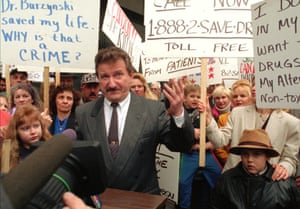CURE FOR
CANCER
WAS DISCOVERED
42 YEARS AGO
By
Søren Nielsen
2019
But has been suppressed several times.
In 1976 Dr. Burzynski discovered a strain of peptides never seen before.
He also discovered that people with cancer, lacked these peptides.
Dr. Burzynski then started giving patients a peptide called "Antineoplaston".
In 1986, Dr. Burzynski presented 40 cured cancer patients to the Texas medical board.

2 years later, the board tried to revoke his medical license.
60 patients petitioned the board for filing complaints.
A trial ensued and the judge found Dr. Burzynski,
"Not guilty" of any crime.
The "FDA", then took Dr. Burzynski to Federal court, and dozens of cured cancer patients testified for Dr. Burzynski.
30+ congressmen wrote to persuade the "FDA" to allow Dr. Burzynski`s clinical trials.
The judge declared a mistrial and the "FDA" dropped all remaining charges.
The "FDA", then allowed Dr. Burzynski to proceed with phase II, clinical trials.
However, court cases continued to plague Dr. Burzynski for 20 more years.
After many set backs, the "FDA", just recently approved one of his medications. Two other medications are currently in final approval.
This Brain Tumor, went into remission in 4 weeks.
Before.
After 4 weeks.
This Tumor in the liver, dissappeared in 6 months.
Here`s Ovarian cancer, that healed in 9 months.
How to survive the fake news about cancer
Based in his Texas clinic, Stanislaw Burzynski claims to cure cancer with a unique "antineoplaston" therapy. Despite operating for decades, according to the US National Cancer Institute (NCI) "other investigators have been unable to duplicate these results".
Since its inception, the clinic has been the subject of numerous "FDA" warnings yet continues to promote itself as capable of curing patients.
And it does not come cheap – the US NCI warns patients that treatment costs upwards of $7,500-$10,000 monthly (£5,600-£7,580) and says:
"The evidence for use of antineoplaston therapy as a treatment for cancer is inconclusive. Controlled clinical trials are necessary to assess the value of this therapy."
Despite negative publicity, it’s business as usual for Burzynski. If anything, crowdfunding may have made his clinic more popular.
In lieu of scientific evidence, it relies on gushing testimonials to lure new customers, though in some cases, these come from patients already deceased – a fact absent from the promotional material.
This is contemptible, but in no way unique – there is an abundance of dubious clinics worldwide promising the impossible at eye-watering prices.
Last year an investigation on Irish television probed clinics in Istanbul that were claiming huge successes with unconventional therapies. Patients were charged more than €130,000 (£116,000) and given the all-clear in Turkey.
According to the programme, patients discovered their cancers had progressed markedly when scanned after returning home. Germany, too, is home to several effectively unregulated clinics, presented as luxury spas but promising cures.
These are backed by fawning testimonials pitched at international customers, with treatments costing hundreds of thousands of euros – despite no evidence for their efficacy.
Such exploitation goes far beyond the immediate victims, with crowdfunding typically used to meet their exorbitant prices.
A paper in the British Medical Journal last year, based on figures collected by the Good Thinking Society, found that at least £8 million had been raised since 2012 in the UK alone for unsubstantiated or discredited cancer treatments.
As Good Thinking Society project director Michael Marshall explains:
"Sums raised through crowdfunding are just the tip of the iceberg, with many patients taking out loans, mortgaging their houses, and spending their life savings. When these supposed cures turn out to offer no benefit, families have been left coping with huge debts when they are grieving for their loved one."
To explain the paucity of evidence for their claims, purveyors of quack remedies accuse the medical and scientific community of suppressing cures for cancer.
This is not a mere fringe belief – 37% of Americans believe the "FDA" is doing just that. But the claim is nonsense.
It would require a vast conspiracy of hundreds of thousands of scientists and doctors to sustain – a scenario unlikely to endure.
Plus, if there were such a conspiracy, wouldn’t those who work in the cancer sphere be just as susceptible to its malignant influence as anyone?
We all lose loved ones to cancer, and succumb to it. Conspiracy claims foster distrust between patients and healthcare teams.
The rise in cancer misinformation is part of a wider problem with online falsehoods. Like the equally dangerous explosion in anti-vaccine myths, cancer untruths have an impact on both our physical wellbeing and on the public understanding of science and medicine.
In a sea of sound and fury, discerning between the reputable and the repugnant isn’t always easy, but there are excellent resources available for patients and their families.
Well-researched guides by Cancer Research UK and the US National Cancer Institute are enlightening and authoritative.
Like anti-vaccine sentiment, cancer myths thrive on social media. There is a strong argument that these platforms have a moral obligation to remove groups and individuals propagating misinformation.
As O’Sullivan notes, "Facebook, YouTube and Twitter lead a patient down a rabbit hole, with many thinking this is ‘doing their research’. I don’t think we can stop those making false cancer claims, but maybe we can insulate patients and regulate those making cancer claims as well as holding social media platforms accountable."
In the wake of a measles resurgence driven in part by online anti-vaccine activism, several social media platforms have promised to massage their algorithms to reduce "fake news" on cancer.
But this filtering is easily bypassed. Social media business models thrive on engagement rather than veracity, and a cynic might think they have little reason to regulate such content, beyond appearing to be concerned.
Whether the problem is absence of ability or inclination, health misinformation remains widespread.
It’s imperative we improve our ability to assess the avalanche of medical claims: our continued wellbeing depends on it.




Ingen kommentarer:
Send en kommentar